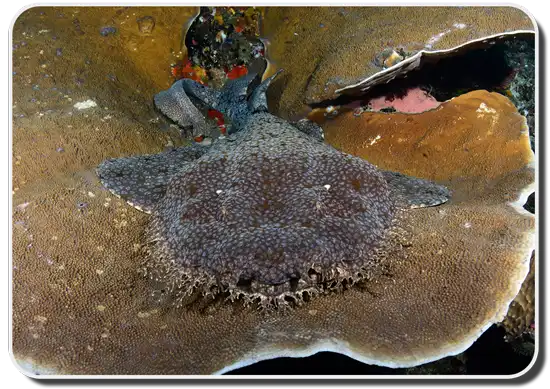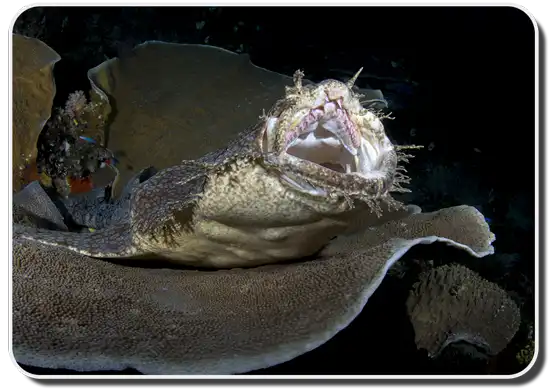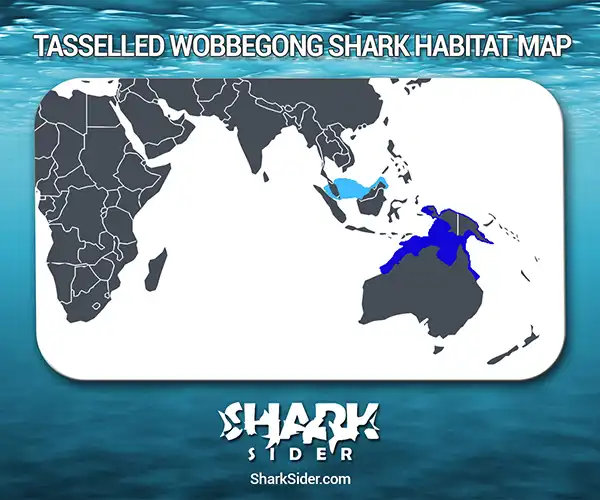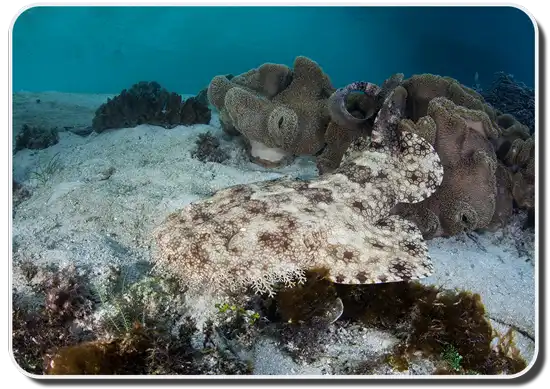The Tasselled Wobbegong is a species of carpet shark that lives on the bottom of the ocean floor and feeds on fish and invertebrates by ambushing them. Also called the bearded or Ogilby’s wobbegong, they take shelter inside caves in coral reefs where they spend most of their lives.

Tasselled Wobbegong Scientific Classification |
|
| Kingdom | Animalia |
| Phylum | Chordata |
| Class | Chondrichthyes |
| Order | Orectolobiformes |
| Family | Orectolobidae |
| Genus | Eucrossorhinus |
| Scientific Name | E. dasypogon |
Description
The Tasselled Wobbegong is around 5.9 ft long with a broad flat body. Their wide heads have distinct branching dermal lobes from the snout tip to the pectoral fins, extending around the chin. These fins, as well as the pelvic fins, are round and large, while the dorsal fins are pretty tall, with the first being significantly larger than the second.
 Their eyes have tubercles on top of them and spiracles behind them. These sharks’ mouths are at the end of their heads, with the upper jaw having 23–26 teeth rows while the lower has 19 rows.
Their eyes have tubercles on top of them and spiracles behind them. These sharks’ mouths are at the end of their heads, with the upper jaw having 23–26 teeth rows while the lower has 19 rows.
On the dorsal region, they are grayish- or yellowish-brown with dark mosaic-like patterns. These patterns extend to the underside of the tail and the ventral pectoral and pelvic fin margins. The remaining ventral surface is white.
Where do they live
Map Of TheTasselled Wobbegong Shark’s Habitat

Tasselled Wobbegongs are spotted throughout the western Pacific, including Eastern Indonesia, New Guinea, and Northern Australia, all around the Great Barrier Reef.
They dwell on the ocean floor, especially around reefs in inshore and offshore waters. While diving, one is most likely to see this wobbegong in reef channels or on top of coral heads.
Behavior
Dietary
This species is an ambush predator, feeding upon nocturnal schooling fishes such as soldierfishes, squirrelfishes, and sweepers sheltering in the same cave as them as well as crustaceans and cephalopods.
Predatory
The near-perfect camouflage of the tasseled wobbegong lets them blend seamlessly into the ocean floor. They let smaller fishes and crustaceans settle atop their heads, attracting larger fishes to be devoured by the wobbegong.
They have also displayed luring behavior, waving their caudal fin to attract prey while the rest of their body remains hidden.
Social
These are solitary species, staying over a small range in which they hunt and rest.
Reproductive
They are ovoviviparous, with a female giving birth to 20 or more pups, each measuring 7-8 inches. While in the womb, the baby sharks get nourishment from eating the egg yolk.
While the exact lifespan remains unknown, there are records of this shark living for about 26 years.

Adaptations
Due to their mottled appearance matching perfectly with the sand and mud present at the bottom of the ocean, they have excellent camouflage. This helps them to both efficiently hunt and avoid being hunted.
Interactions with humans
While not generally dangerous, the Tasselled Wobbegong will attack if provoked. Plenty of swimmers and divers have been bitten when they accidentally stepped on one, or the shark mistook a foot or hand dangling in front of it for a suitable meal.
The IUCN lists it as a species of “Least Concern” or “LC” as of 2015, though it is worth noting that it is at risk of habitat degradation and climate change.
